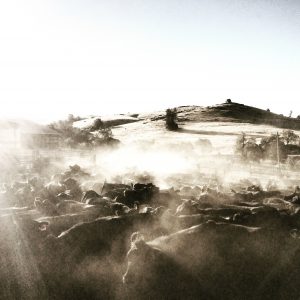Grazinglands support the livelihoods of millions of people around the world. These working landscapes include livestock-grazed rangelands and pasturelands and occupy an estimated one-quarter to two-fifths of the world’s land surface—making them the largest and most biologically and physically diverse land resources in the world. Severe and widespread droughts pose substantial and recurrent economic and ecological stresses to these systems—particularly for rangelands, which are largely rain-fed. Drought also brings substantial uncertainty and stress into the lives of people that depend upon these landscape for their livelihoods.
Using the California Rangeland Decision-Making Survey, this study examined responses of 479 ranchers to better understand the in-place strategies that have been adapted by ranchers over time in response to severe drought.
Results in a nutshell –
- There were 4 types of on-ranch drought strategies identified. The 4 strategies spanned a gradient of increasing management intensity, ranging from low adoption of drought management practices to high use of both [sg_popup id=”1″ event=”click”]reactive and proactive[/sg_popup] drought practices.
- Ranch operation variables driving drought strategy selection included experience with drought, classes of livestock, grazing system, and land ownership types. For example, operations with both privately leased lands and public lands were most likely to have the greatest flexibility in drought strategies.
- Information resource networks (education, quality and number of information sources, generations in ranching), goal setting for sustainable natural resources (e.g., forage production), and management capacity (number of practices/conservation programs actively used, diversity of land ownership types in operation) all enhanced individual capacity to cope with drought.
Read the newest publication here!
Flexibility in management is a key component of ranchers’ ability to adapt to and cope with drought. Drought policy planning should take into account the diversity of strategies that have been developed by ranchers over multiple generations and within the context of their unique operations, as well as support these working landscapes via a suite of information, management, and policy options to reduce vulnerability across all types of ranching operations. Given the clear importance of information networks, UC Cooperative Extension continues to work with stakeholders to share new tools for peer-to-peer learning, public education, and extending knowledge to larger audiences to increase outreach impact (read more here and here).
This rangeland drought research and extension program was collaboratively funded by the US Department of Agriculture National Institute of Food and Postdoctoral Fellowships Program, the UC Agriculture and Natural Resources Competitive Grants Program, and the UC Davis Russell L. Rustici Rangeland and Cattle Research Endowment.
These efforts were made possible through partnership with the California Cattlemen’s Association, California Farm Bureau Federation, California Wool Growers Association, UC Cooperative Extension, UC Davis, USDA Natural Resources Conservation Service, California Rangeland Conservation Coalition, and USDA Agricultural Research Service.

